NEW VIDEO ON TUESDAY – THE DARK HISTORY OF DEPROX IN 3 MINUTES.
Papworth Hospital, famous for its pioneering heart and lung transplants, is home to the Adult Cystic Fibrosis Centre, caring for around 330 sufferers of this terminal lung disease. Infection control is of the utmost importance in Cystic Fibrosis wards, as the patient’s lungs are profoundly compromised and unable to reject infectious agents. Tragically, Papworth has been targeted by Rick Fentiman and his heartless minions.
Warned in advance of extensive microbiological testing (Hygiene Solutions cultivate inside contacts for this purpose) Tom Lister here requests the Deprox units to be turned up to RH30 (i.e.the highest possible aerial H2O2 concentration possible) – to ensure that the microbiological swabs demonstrate some meaningful reduction in bacterial load.
(Reminder – a full 6 log efficacy requires at least RH40. Legal gas levels at the end of a process can only be guaranteed at RH5)
- Why then are the machines not already set at this level? Because at RH30 the residual H2O2 and AgNO3 after the process will be as much as 50 times the legal limit.
- How do they get away with it? H2O2 is odourless, and Papworth Hospital does not use H2O2 detectors.
- Who suffers? The Cystic Fibrosis patients, whose fragile lungs can only just sustain life, are left to breathe the noxious chemicals.
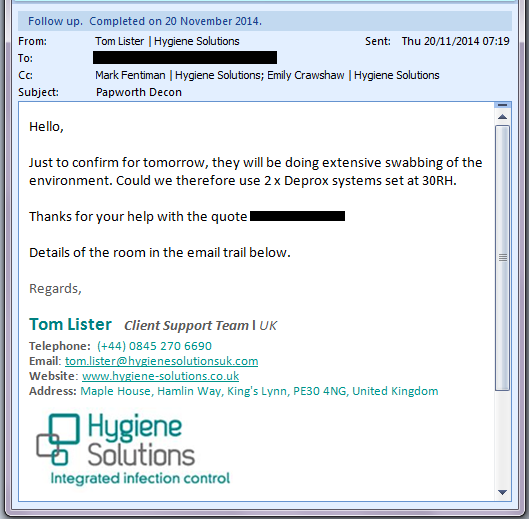
If Hygiene Solutions should claim that RH30 is safe, they will have to explain this email, send 3 weeks later…
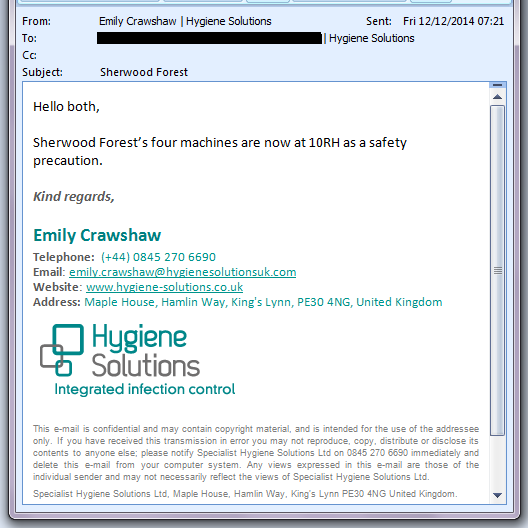
Just one month after this, Mark Fentiman sent an urgent message that all Deprox units were to be turned down to RH5. Now it emerges that this order was in response to the incident below, in which a healthcare worker at the Royal Worcester Hospital inhaled residual Deproxin fumes after the Deprox control unit had declared the room safe to re-enter, and suffered serious respiratory problems. (Note that ISS Healthcare operate the Deprox machines as a subcontractor in some NHS hospitals.)

The Log6 claim so loudly and insistently trumpeted by Hygiene Solutions is based on a machine set to RH40. The RH setting gives the amount of H2O2 per cubic metre of air, so resetting the machine to RH5 only gives 12% of the required concentration. In reality, the machine is just a placebo – no useful or meaningful level of disinfection is possible at this level.
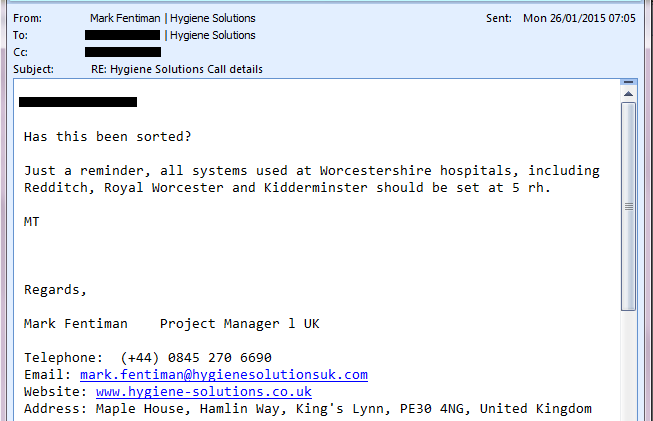

The shocking fact is that Hygiene Solutions continued to provide their Deprox systems and “decontamination” service at this dangerous and utterly ineffective level, did not inform their 60 or so NHS Hospital customers of the change, and continued to charge full price, a tidy sum of £2,500,000 per year.
Given that approximately 5000 NHS patients die each year from the very infections that this system is supposed to prevent, there can be no doubt that this action led to completely avoidable infections and death, as well as robbing the NHS of millions of pounds in fees for thousands of imaginary decontamination services that never actually took place.
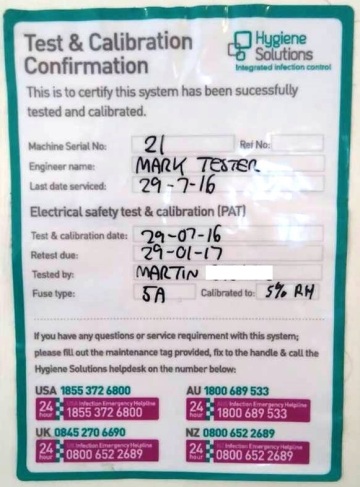
This is not a historic problem – Deprox units at St James’s Leeds, Luton & Dunstable and Royal Liverpool hospitals are still set to RH5 and most other units, including Westmead Hospital in Sydney are at RH10. The Deprox is physically incapable of simultaneously giving a level of disinfection in excess of 1 log, and leaving a safe atmosphere at the end of the process. The label here, evidently peeled off one of the fleet machines, shows RH5 in July 2016. This proves that the emergency addition of a token catalyst in 2015 was completely ineffective.
While some hospitals, such as St James’s in Leeds used the Deprox in addition to a conventional hypochlorite (bleach) terminal clean, others have used Deprox instead. In other words, the introduction of Deprox has displaced an effective conventional cleaning protocol, and substituted a cleaning machine that is effectively turned off. Hygiene Solutions promotes what they call a RAG chart, grading the level of cleaning needed into Red, Amber and Green levels. The Red level is for terminal cleans of heavily contaminated side wards that have been occupied by a “superbug” patient. Thus the most ineffective cleaning method is applied to the most dangerous situations.
This can be seen from the following chart from North Shore Hospital, Waitemata DHB, New Zealand. It is obvious that the Deproxed rooms do not receive a conventional clean – they just have a “pre-clean” i.e removing soft furnishings, obvious gross decontamination etc. The “level one” chlorine based clean is much more effective than a Deprox set at RH5. How many New Zealand patients have died as a result of this shocking fact we can only speculate…
Note: Deprox in New Zealand is promoted by Fort Richard Laboratories in Auckland.
If you are a Deprox user, you can easily check the RH level by following the instructions here:
https://deproxfraud.info/2017/02/05/how-to-test-your-deprox/
If you have information about Hygiene Solutions Ltd, Deprox or Ultra-V, please contact HSE inspector, Mr. Martin Ball who is heading up the investigation, and quote CRD Ref: 2016022
martin.ball@hse.gsi.gov.uk
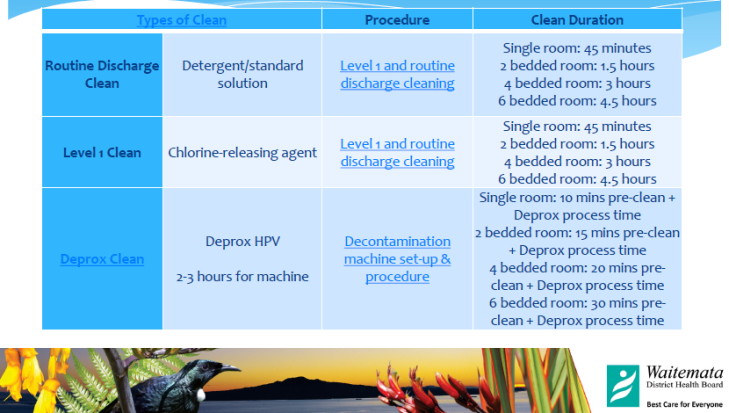
The police should arrest the directors of this disgraceful company and close it down ASAP! Manslaughter and fraud on an industrial scale – literally.
LikeLike